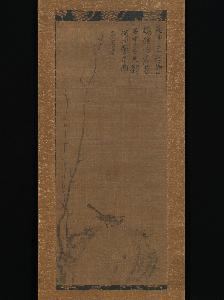Taikyo Genju
太虚元寿;Taikyo Genju
Place: Japan
Biography:
Taikyo Genju was a Japanese artist who was active during the Nanbokuchō period (1336–92). He is known for his ink paintings on silk, including the artwork 'Wagtail on a Rock'. This painting, measuring 83.2cm x 34.9cm and executed on silk, encapsulates the essence of spiritual pursuit and self-discovery.
The Artist's Journey
Taikyo Genju was a prominent figure in Japanese art, known for his exquisite skill and mastery of ink paintings on silk. His works often depicted spiritual and philosophical themes, reflecting the artist's deep understanding of Zen philosophy. The 'Wagtail on a Rock' painting is a poignant representation of this philosophy, showcasing the artist's ability to capture the essence of spiritual pursuit and self-discovery.
Artistic Style
Taikyo Genju's artistic style was characterized by his use of ink and silk, which were traditional materials in Japanese art. His paintings often featured delicate and intricate designs, showcasing the artist's mastery of the medium. The 'Wagtail on a Rock' painting is a prime example of this style, with its delicate ink lines and intricate design.
Influences and Legacy
Taikyo Genju's work was influenced by the Nihonga Art Movement, which emerged during the Meiji period (1868-1912). This movement sought to revitalize traditional Japanese art forms, such as ink painting and calligraphy. Taikyo Genju's paintings, including 'Wagtail on a Rock', are considered some of the finest examples of this style.
- Taikyo Genju's 'Wagtail on a Rock' is a masterpiece of Zen philosophy and artistic expression.
- The 'Wagtail on a Rock' painting is a poignant representation of spiritual pursuit and self-discovery.
- Taikyo Genju's artistic style was characterized by his use of ink and silk, which were traditional materials in Japanese art.
Taikyo Genju's legacy continues to be celebrated through his paintings, including 'Wagtail on a Rock', which can be found at the Taikyo Genju page on Wikioo.org. His work remains an important part of Japanese art history, and his influence can still be seen in contemporary art today.

